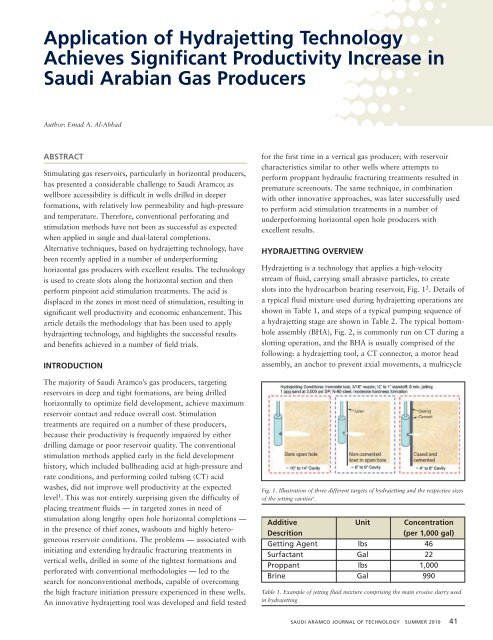English Edition (6 MB pdf) - Saudi Aramco
English Edition (6 MB pdf) - Saudi Aramco
English Edition (6 MB pdf) - Saudi Aramco
Create successful ePaper yourself
Turn your PDF publications into a flip-book with our unique Google optimized e-Paper software.
Application of Hydrajetting Technology<br />
Achieves Significant Productivity Increase in<br />
<strong>Saudi</strong> Arabian Gas Producers<br />
Author: Emad A. Al-Abbad<br />
ABSTRACT<br />
Stimulating gas reservoirs, particularly in horizontal producers,<br />
has presented a considerable challenge to <strong>Saudi</strong> <strong>Aramco</strong>; as<br />
wellbore accessibility is difficult in wells drilled in deeper<br />
formations, with relatively low permeability and high-pressure<br />
and temperature. Therefore, conventional perforating and<br />
stimulation methods have not been as successful as expected<br />
when applied in single and dual-lateral completions.<br />
Alternative techniques, based on hydrajetting technology, have<br />
been recently applied in a number of underperforming<br />
horizontal gas producers with excellent results. The technology<br />
is used to create slots along the horizontal section and then<br />
perform pinpoint acid stimulation treatments. The acid is<br />
displaced in the zones in most need of stimulation, resulting in<br />
significant well productivity and economic enhancement. This<br />
article details the methodology that has been used to apply<br />
hydrajetting technology, and highlights the successful results<br />
and benefits achieved in a number of field trials.<br />
INTRODUCTION<br />
The majority of <strong>Saudi</strong> <strong>Aramco</strong>’s gas producers, targeting<br />
reservoirs in deep and tight formations, are being drilled<br />
horizontally to optimize field development, achieve maximum<br />
reservoir contact and reduce overall cost. Stimulation<br />
treatments are required on a number of these producers,<br />
because their productivity is frequently impaired by either<br />
drilling damage or poor reservoir quality. The conventional<br />
stimulation methods applied early in the field development<br />
history, which included bullheading acid at high-pressure and<br />
rate conditions, and performing coiled tubing (CT) acid<br />
washes, did not improve well productivity at the expected<br />
level 1 . This was not entirely surprising given the difficulty of<br />
placing treatment fluids — in targeted zones in need of<br />
stimulation along lengthy open hole horizontal completions —<br />
in the presence of thief zones, washouts and highly hetero -<br />
geneous reservoir conditions. The problems — associated with<br />
initiating and extending hydraulic fracturing treatments in<br />
vertical wells, drilled in some of the tightest formations and<br />
perforated with conventional methodologies — led to the<br />
search for nonconventional methods, capable of overcoming<br />
the high fracture initiation pressure experienced in these wells.<br />
An innovative hydrajetting tool was developed and field tested<br />
for the first time in a vertical gas producer; with reservoir<br />
characteristics similar to other wells where attempts to<br />
perform proppant hydraulic fracturing treatments resulted in<br />
premature screenouts. The same technique, in combination<br />
with other innovative approaches, was later successfully used<br />
to perform acid stimulation treatments in a number of<br />
underperforming horizontal open hole producers with<br />
excellent results.<br />
HYDRAJETTING OVERVIEW<br />
Hydrajetting is a technology that applies a high-velocity<br />
stream of fluid, carrying small abrasive particles, to create<br />
slots into the hydrocarbon bearing reservoir, Fig. 1 2 . Details of<br />
a typical fluid mixture used during hydrajetting operations are<br />
shown in Table 1, and steps of a typical pumping sequence of<br />
a hydrajetting stage are shown in Table 2. The typical bottomhole<br />
assembly (BHA), Fig. 2, is commonly run on CT during a<br />
slotting operation, and the BHA is usually comprised of the<br />
following: a hydrajetting tool, a CT connector, a motor head<br />
assembly, an anchor to prevent axial movements, a multicycle<br />
Fig. 1. Illustration of three different targets of hydrajetting and the respective sizes<br />
of the jetting cavities 6 .<br />
Additive Unit Concentration<br />
Descrition<br />
(per 1,000 gal)<br />
Getting Agent lbs 46<br />
Surfactant Gal 22<br />
Proppant lbs 1,000<br />
Brine Gal 990<br />
Table 1. Example of jetting fluid mixture comprising the main erosive slurry used<br />
in hydrajetting<br />
SAUDI ARAMCO JOURNAL OF TECHNOLOGY SUMMER 2010 41

















